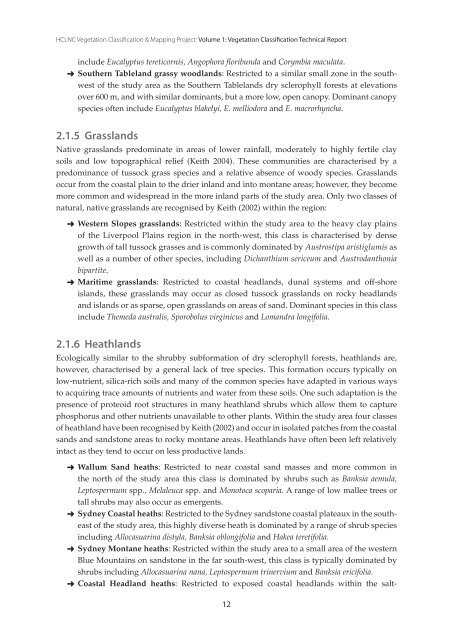Free Download - HCCREMS
Free Download - HCCREMS
Free Download - HCCREMS
Create successful ePaper yourself
Turn your PDF publications into a flip-book with our unique Google optimized e-Paper software.
HClNC Vegetation Classification & mapping Project: Volume 1: Vegetation Classification Technical Report<br />
include Eucalyptus tereticornis, Angophora floribunda and Corymbia maculata.<br />
➜ Southern tableland grassy woodlands: Restricted to a similar small zone in the southwest<br />
of the study area as the Southern Tablelands dry sclerophyll forests at elevations<br />
over 600 m, and with similar dominants, but a more low, open canopy. Dominant canopy<br />
species often include Eucalyptus blakelyi, E. melliodora and E. macrorhyncha.<br />
2.1.5 Grasslands<br />
Native grasslands predominate in areas of lower rainfall, moderately to highly fertile clay<br />
soils and low topographical relief (Keith 2004). These communities are characterised by a<br />
predominance of tussock grass species and a relative absence of woody species. Grasslands<br />
occur from the coastal plain to the drier inland and into montane areas; however, they become<br />
more common and widespread in the more inland parts of the study area. Only two classes of<br />
natural, native grasslands are recognised by Keith (2002) within the region:<br />
➜ Western Slopes grasslands: Restricted within the study area to the heavy clay plains<br />
of the Liverpool Plains region in the north-west, this class is characterised by dense<br />
growth of tall tussock grasses and is commonly dominated by Austrostipa aristiglumis as<br />
well as a number of other species, including Dichanthium sericeum and Austrodanthonia<br />
bipartite.<br />
➜ Maritime grasslands: Restricted to coastal headlands, dunal systems and off-shore<br />
islands, these grasslands may occur as closed tussock grasslands on rocky headlands<br />
and islands or as sparse, open grasslands on areas of sand. Dominant species in this class<br />
include Themeda australis, Sporobolus virginicus and Lomandra longifolia.<br />
2.1.6 Heathlands<br />
Ecologically similar to the shrubby subformation of dry sclerophyll forests, heathlands are,<br />
however, characterised by a general lack of tree species. This formation occurs typically on<br />
low-nutrient, silica-rich soils and many of the common species have adapted in various ways<br />
to acquiring trace amounts of nutrients and water from these soils. One such adaptation is the<br />
presence of proteoid root structures in many heathland shrubs which allow them to capture<br />
phosphorus and other nutrients unavailable to other plants. Within the study area four classes<br />
of heathland have been recognised by Keith (2002) and occur in isolated patches from the coastal<br />
sands and sandstone areas to rocky montane areas. Heathlands have often been left relatively<br />
intact as they tend to occur on less productive lands.<br />
➜ Wallum Sand heaths: Restricted to near coastal sand masses and more common in<br />
the north of the study area this class is dominated by shrubs such as Banksia aemula,<br />
Leptospermum spp., Melaleuca spp. and Monotoca scoparia. A range of low mallee trees or<br />
tall shrubs may also occur as emergents.<br />
➜ Sydney Coastal heaths: Restricted to the Sydney sandstone coastal plateaux in the southeast<br />
of the study area, this highly diverse heath is dominated by a range of shrub species<br />
including Allocasuarina distyla, Banksia oblongifolia and Hakea teretifolia.<br />
➜ Sydney Montane heaths: Restricted within the study area to a small area of the western<br />
Blue Mountains on sandstone in the far south-west, this class is typically dominated by<br />
shrubs including Allocasuarina nana, Leptospermum trinervium and Banksia ericifolia.<br />
➜ Coastal headland heaths: Restricted to exposed coastal headlands within the salt-<br />
12


